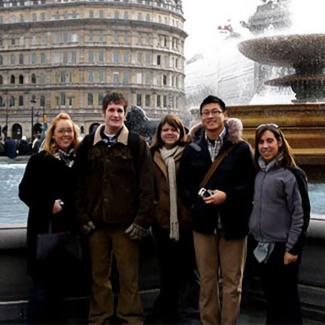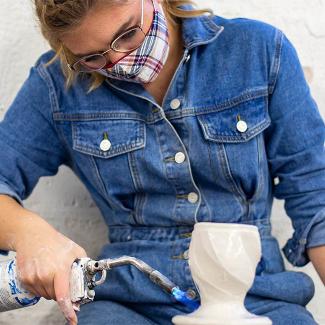What you'll learn studying Art History at UW-Platteville
Art history connects the practice of making art with its historical context. You don’t need to be an art history major to pursue an interest in this field. Develop a strong understanding of the historical, social, and political dimensions of art and architecture with a minor in art history through the Department of Performing and Visual Arts. The UW-Platteville Art History program provides an art historical education that is balanced and diverse culturally, temporally, and geographically.
Connect the practice of making art with its historical context by examining the breadth and depth, and span from the ancient world to the art of Asia, including modern and contemporary Europe and the United States. In your art history courses, you’ll study the media of painting, sculpture, photography, design, material culture, architecture, and urbanism. There are also cross-departmental art history classes, such as Native American Art and Women and the Arts, which provoke interdisciplinary questions about the functioning of art with regards to vital issues such as ethnicity and gender.
The addition of a minor in art history is designed for students who seek to study art history in depth as a complement to their major area of study. Review the full minor requirements.
Careers in Art History
Earning an art history degree involves learning about the evolution of art and culture over time. Art history university coursework also teaches valuable skills which can serve graduates well in almost any career. You’ll graduate from college prepared for a career as an artist, gallery assistant or owner, and various opportunities with museums. However, you will also have the research, analytical, organizational, and communication skills needed for success in an array of other types of roles. You could pair your love of art and history with other passions to work in journalism, travel and tourism, marketing, and more.
Some of the many roles you could pursue after studying art history include:
- Architect
- Archivist
- Art auction specialist
- Art director
- Art framer
- Art historian
- Art manager
- Art teacher
- Art therapist
- Curator
- Gallery manager
- Graphic designer
- Heritage site manager
- Independent artist
- Journalist
- Museum conservator
- Photographer
- Publishing manager
- Tour guide
If you choose a traditional art history role working for a museum, or as an archivist or curator, you can expect to oversee one or more collections of artwork or historical items, preparing them for exhibition and restoring/maintaining them. You will probably work in a museum, government agency, historical site, or for a college or university, where you can share your passion for art history with the public.

Discover by doing
Students studying art history at UW-Platteville learn both inside and outside the classroom. Trips to museums and historic sites such as the Art Institute of Chicago and Taliesin provide vital first-hand experiences. These expeditions can be life-changing by way of the acquisition of knowledge in the realm of art’s historical, material, economic, and contemporary significance. Students can also complete research projects, internships, and attend university events to gain deeper insight into this field.

Explore Art through travel
The Department of Performing and Visual Arts offers a variety of opportunities to travel, study abroad, or participate in short-term faculty-led courses. From studying British theatre in London to exploring art in Italy, nothing can compare with encountering the places and culture. Education abroad experiences provide you with valuable life skills, strengthen your confidence, shape your understanding of cross-cultural relations, and help prepare you for a world beyond graduation. Many of the faculty are experienced travelers and provide diverse opportunities.




